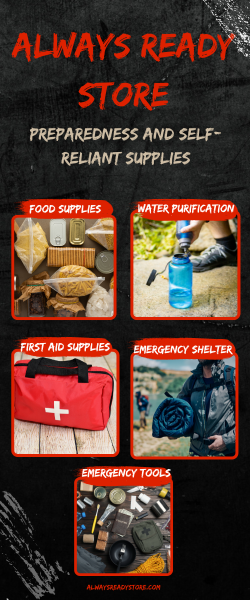
by Preparation | Mar 28, 2025 | Preparation Call, Preparation Guide, Preparation Supplies

PREPARE Magazine
Prepare Magazine aims to help people all over the world to learn how to be prepared for the challenging times that may be ahead. It may seem impossible to some, but with the right resources, training and lots of encouragement, it is attainable. You can learn more about preparedness by visiting www.preparemag.com/subscribe and you will get a free 0ne-year digital subscription.
Prepare magazine offers training in survival skills, self-sufficient living and preparedness for what lies ahead in the future. In our journey through life, fear engulfs the hearts of many and often results to poor decisions. Through the help of Prepare Magazine, you will be taught how to live more frugally, how to be self-sufficient, how to save money, how to forage for food and water, survival skills and everything in between that will help you prepare for the difficult times.
At www.preparemag.com/subscribe, like-minded people are encouraged to share their tips, ideas, suggestions and skills for the benefit of the community. Prepare magazine is not just any ordinary magazine – It is about life, its challenges and how to survive them. In this time of chaos and disarray, staying calm and focused is essential. With the help of experts, proper resources and tools from Prepare Magazine, you are well-prepared for life.

by Preparation | Mar 28, 2025 | Preparation Guide, Preparation Supplies, Preparedness
 Water is among the standard demands of guys and among the most important aspects of life. It is crucial for numerous reasons. It is required for hydration in order to endure. Individuals have to consume water frequently in order to renew the loss of fluid in the body and to quench the thirst.
Water is among the standard demands of guys and among the most important aspects of life. It is crucial for numerous reasons. It is required for hydration in order to endure. Individuals have to consume water frequently in order to renew the loss of fluid in the body and to quench the thirst.
Water is vital to a body. Pure water is required for optimum health. It is likewise utilized for other vital tasks of men such as bathing, cleaning and food preparation.
Water can come from rain, stream or with other sources. Water is brought in houses with plumbing from regional water stations. Residences can save water using a water tank. Some designs of water storage tank can be used to gather rain water.
A clean, decontaminated bottle can be used for water storage. Containers made from thermoplastic have been designed for water storage. Since ancient times, individuals have actually invented containers from different products for the function for storing water.
Water storage containers are essential for survival in a wilderness adventure. A water storage container is among the few essential things that can be brought by survivalist campers. A bottle is maybe the most popular mobile type of water storage. It can be of different designs, materials and shapes. The Sigg bottle, a Swiss-made water storage container made from true aluminum is among the popular bottles for outdoor activities. It has been thought about by Backpacker Magazine as one of the most difficult water bottles in the world.
The company that produces Sigg bottle was established in Biel, Switzerland by Ferdinand Sigg in 1908. It used to make kitchenware and electrical devices made from aluminum. However, in 1998, it focused on producing aluminum bottles. The Sigg Bottle is among the most identifiable brand names of aluminum bottles in Europe.
Though made from aluminum, Sigg bottles can be available in numerous designs. Different online shops have actually offered Sigg bottles on their product. You can discover this product together with other outdoor devices products. Nalgene bottles and bottles of different brand names can also be found in the market.
An oasis is water storage in the desert. A well is a popular type of water storage where people can acquire water at no expense. Water tank is utilized to collect water in homes and in plants. Keeping water can be essential in times of dry spell and deficiency of water supply. Water is needed for survival. Although the earth is fulled of water, just a particular percentage is suitable for consuming.

by Preparation | Mar 28, 2025 | Preparation Guide, Preparation Supplies, Preparedness
 Today, many families are preparing for what they fear is a pending doomsday scenario. It seems that everywhere you turn, there is a new warning about a cataclysmic event that will thrust us back into a primitive society and change our lives forever. News media and conspiracy mongers are churning-up their fear stories, and record numbers of people are tuning-in to hear the latest discouraging report.
Today, many families are preparing for what they fear is a pending doomsday scenario. It seems that everywhere you turn, there is a new warning about a cataclysmic event that will thrust us back into a primitive society and change our lives forever. News media and conspiracy mongers are churning-up their fear stories, and record numbers of people are tuning-in to hear the latest discouraging report.
It sure seems like we can’t get enough of the news of pending disasters. You would think we were passing a car-wreck on the highway and frantically turning our heads to see what we might view in the carnage. Are we so fixated on disaster and chaos that we get drawn-in by the very possibility that we just might be involved in some tragedy of massive proportions?
When you really think about it, our culture has been well-conditioned to expect and react to fear and tragedy. In fact, our society feeds on disaster and pays handsomely to be entertained with gore, horror, and violence. Hollywood knows our nature, and continues to crank-out disturbing films because they profit from our appetite for being frightened and disgusted with images of pain and suffering.
I certainly don’t believe that everyone has a desire to dwell on the sufferings of others, but we can’t ignore that marketing research shows that tragedy increases viewership. With that being the case, it certainly stands to reason that media outlets have a major opportunity to ramp-up the fear tones and cash-in on the gloom reports and conspiracies.
A while back I wrote an article called “Doomsday Survival, or Preparation Call”. The gist of that article is generally about the reaction (and over-reaction) of fear that has driven the preparedness movement. I know I get on a soapbox, but I just get so disappointed in seeing and hearing about so many families rushing-about preparing for the pending doomsday scenario. People are hoarding food and supplies, booby-trapping their land, buying every weapon they can find, and even purchasing underground bunkers to survive-in when this cataclysmic disaster occurs.
Now, certainly I believe we need to be in preparation. I don’t need to watch the news to know that there are difficulties ahead that we need to prepare for. I can’t even get a weather forecast that is accurate, why should I expect for a minute that CNN will give me any reasonable information to help me prepare my family?
The concern I have is, there are a lot of people yelling “fire” in a crowded area. People are being trampled and hurt because some over-dramatic people are screaming fear and pain. It’s fueling the panic, and people are being hurt.
I’ve been preaching the need for preparedness for a long time. In fact, I felt a “call” to prepare over 25 years ago. The preparedness call I felt, was not about fear and suffering. It was not about huddling in my lookout tower and waiting with my gun to shoot my neighbor who was coming to me for help. The preparation call I received was about getting my family ready, so we would not be in panic when things get a bit difficult – and will be able to help others. My preparation call was about getting ready, spiritually, emotionally, financially, and physically. Getting prepared was never a reaction to fear, but being ready so we could react with calm.
Here is the thing for me… a few years back we stored a lot of supplies and thought we were ready for the big catastrophic doomsday show. I mean, I thought… bring it on, because we have extra pop-tarts if the grid goes down. How naive, and silly to assume we were “prepared” for disaster because we had a few hundred pounds of dry goods. Granted we were better prepared than most, but emotionally… I imagine if the power was off for two days there would have been intense wailing and gnashing of teeth!
The fact is, many people today are storing some food and water, and have candles at-the-ready. They assume they are well-prepared because they have a month’s supply of food in the basement.
Even the most avid “prepper” assumes they are ready. They may have six-months of supplies, and can shoot a deer at 150 yards, but… I really wonder if they are truly prepared. Are they ready to really endure the disruption of life as we know it?
I’ve thought often about this and wonder how we might all react to overwhelming tragedy. Will we bond together and help each other overcome the difficulty, or will we do like many preppers are planning – hide in the hills and expect to shoot the first person who crosses our aim.
How will our families survive, if a spouse is overwhelmed with the intense shock of the situation and just can not cope with the situation? Are we so tough that we assume our family will all just hold hands and laugh while eating our ready meals? A lot of the families I know can’t even sit together for thirty minutes, so I doubt they will be ready to huddle around a candle and tell stories.
So, are we preparing for the emotional shock that might come from a massive catastrophe? Are we preparing to turn family and friends away because we don’t have enough food for our long-term survival, if we feed them?
If my heart becomes so hardened during perilous times that I am capable of turning-away families who need food or help, then I really don’t want to prepare. What kind of life is left for us, if we ignore the hurting people inside our community simply because they were too naive or lazy to get ready?
I realize many will disagree, and that’s fine. I certainly do not have a moral badge that gives me any authority to pass judgement. The point I’m trying to make is… today (before a tragedy hits) I can not see me turning away someone who comes to me for help.
So, unfortunately, I think we have a long way to go before we are truly prepared. In my humble view, there is far too much emphasis on loading guns and stashing grub. For s0me, that’s their ultimate strategy – survival at all cost. That’s fine, and certainly important. But… if we lose our moral values and conscience in being open to helping our neighbors – what will our society look like post-doomsday?
Bottom line in my rant ….
Get Prepared – but do not prepare because you are afraid. Prepare emotionally, spiritually, and physically. Prepare now to answer the question… what will I do when my neighbor comes to me for help?
Seek God, and His peace. One of my favorite passages of Scripture says:
So do not fear, for I am with you;
do not be dismayed, for I am your God.
I will strengthen you and help you;
I will uphold you with my righteous right hand.
Isaiah 41:10

by Preparation | Mar 28, 2025 | Preparation Call, Preparation Guide, Preparation Supplies, Preparedness
 Today, many families are preparing for what they fear is a pending doomsday scenario. It seems that everywhere you turn, there is a new warning about a cataclysmic event that will thrust us back into a primitive society and change our lives forever. News media and conspiracy mongers are churning-up their fear stories, and record numbers of people are tuning-in to hear the latest discouraging report.
Today, many families are preparing for what they fear is a pending doomsday scenario. It seems that everywhere you turn, there is a new warning about a cataclysmic event that will thrust us back into a primitive society and change our lives forever. News media and conspiracy mongers are churning-up their fear stories, and record numbers of people are tuning-in to hear the latest discouraging report.
It sure seems like we can’t get enough of the news of pending disasters. You would think we were passing a car-wreck on the highway and frantically turning our heads to see what we might view in the carnage. Are we so fixated on disaster and chaos that we get drawn-in by the very possibility that we just might be involved in some tragedy of massive proportions?
When you really think about it, our culture has been well-conditioned to expect and react to fear and tragedy. In fact, our society feeds on disaster and pays handsomely to be entertained with gore, horror, and violence. Hollywood knows our nature, and continues to crank-out disturbing films because they profit from our appetite for being frightened and disgusted with images of pain and suffering.
I certainly don’t believe that everyone has a desire to dwell on the sufferings of others, but we can’t ignore that marketing research shows that tragedy increases viewership. With that being the case, it certainly stands to reason that media outlets have a major opportunity to ramp-up the fear tones and cash-in on the gloom reports and conspiracies.
A while back I wrote an article called “Doomsday Survival, or Preparation Call“. The gist of that article is generally about the reaction (and over-reaction) of fear that has driven the preparedness movement. I know I get on a soapbox, but I just get so disappointed in seeing and hearing about so many families rushing-about preparing for the pending doomsday scenario. People are hoarding food and supplies, booby-trapping their land, buying every weapon they can find, and even purchasing underground bunkers to survive-in when this cataclysmic disaster occurs.
Now, certainly I believe we need to be in preparation. I don’t need to watch the news to know that there are difficulties ahead that we need to prepare for. I can’t even get a weather forecast that is accurate, why should I expect for a minute that CNN will give me any reasonable information to help me prepare my family?
The concern I have is, there are a lot of people yelling “fire” in a crowded area. People are being trampled and hurt because some over-dramatic people are screaming fear and pain. It’s fueling the panic, and people are being hurt.
I’ve been preaching the need for preparedness for a long time. In fact, I felt a “call” to prepare over 25 years ago. The preparedness call I felt, was not about fear and suffering. It was not about huddling in my lookout tower and waiting with my gun to shoot my neighbor who was coming to me for help. The preparation call I received was about getting my family ready, so we would not be in panic when things get a bit difficult – and will be able to help others. My preparation call was about getting ready, spiritually, emotionally, financially, and physically. Getting prepared was never a reaction to fear, but being ready so we could react with calm.
Here is the thing for me… a few years back we stored a lot of supplies and thought we were ready for the big catastrophic doomsday show. I mean, I thought… bring it on, because we have extra pop-tarts if the grid goes down. How naive, and silly to assume we were “prepared” for disaster because we had a few hundred pounds of dry goods. Granted we were better prepared than most, but emotionally… I imagine if the power was off for two days there would have been intense wailing and gnashing of teeth!
The fact is, many people today are storing some food and water, and have candles at-the-ready. They assume they are well-prepared because they have a month’s supply of food in the basement.
Even the most avid “prepper” assumes they are ready. They may have six-months of supplies, and can shoot a deer at 150 yards, but… I really wonder if they are truly prepared. Are they ready to really endure the disruption of life as we know it?
I’ve thought often about this and wonder how we might all react to overwhelming tragedy. Will we bond together and help each other overcome the difficulty, or will we do like many preppers are planning – hide in the hills and expect to shoot the first person who crosses our aim.
How will our families survive, if a spouse is overwhelmed with the intense shock of the situation and just can not cope with the situation? Are we so tough that we assume our family will all just hold hands and laugh while eating our ready meals? A lot of the families I know can’t even sit together for thirty minutes, so I doubt they will be ready to huddle around a candle and tell stories.
So, are we preparing for the emotional shock that might come from a massive catastrophe? Are we preparing to turn family and friends away because we don’t have enough food for our long-term survival, if we feed them?
If my heart becomes so hardened during perilous times that I am capable of turning-away families who need food or help, then I really don’t want to prepare. What kind of life is left for us, if we ignore the hurting people inside our community simply because they were too naive or lazy to get ready?
I realize many will disagree, and that’s fine. I certainly do not have a moral badge that gives me any authority to pass judgement. The point I’m trying to make is… today (before a tragedy hits) I can not see me turning away someone who comes to me for help.
So, unfortunately, I think we have a long way to go before we are truly prepared. In my humble view, there is far too much emphasis on loading guns and stashing grub. For s0me, that’s their ultimate strategy – survival at all cost. That’s fine, and certainly important. But… if we lose our moral values and conscience in being open to helping our neighbors – what will our society look like post-doomsday?
Bottom line in my rant ….
Get Prepared – but do not prepare because you are afraid. Prepare emotionally, spiritually, and physically. Prepare now to answer the question… what will I do when my neighbor comes to me for help?
Seek God, and His peace. One of my favorite passages of Scripture says:
So do not fear, for I am with you;
do not be dismayed, for I am your God.
I will strengthen you and help you;
I will uphold you with my righteous right hand.
Isaiah 41:10

by Preparation | Mar 28, 2025 | Preparation Call, Preparation Guide, Preparation Supplies
 The story of Joseph gives us an important example a Preparation Call. His obedience, and extraordinary journey of finding his true identity is an amazing inspiration to those who have sometimes struggled with accepting the preparation call. Overcoming the difficulties will often be necessary to get us ready for what God has planned for us.
The story of Joseph gives us an important example a Preparation Call. His obedience, and extraordinary journey of finding his true identity is an amazing inspiration to those who have sometimes struggled with accepting the preparation call. Overcoming the difficulties will often be necessary to get us ready for what God has planned for us.
Joseph’s journey took him from a pit of slavery to the palace of Pharaoh. Joseph traveled this journey one step at a time after his brothers left him for to perish in a deep pit. When we are rejected (especially by those closest to us) it makes us feel useless, and even tempted to be bitter. But, we must rise-above that pit as quickly as possible.
When we cry out to the Lord, He will certainly lift us out of the pit and establish our path. He orders our steps, and gives us provision for the journey.
In the tale of Joseph, God not only raised him up out of the pit of bondage, He also raised him to the Second highest position in the land of Egypt.
When we review Genesis 37-50 we can see it wasn’t an easy journey. Joseph was rejected by his brothers, sold into slavery, and later on betrayed and shackled away in jail. Nonetheless, Joseph did not fear what man can do to him; he forgave those who hurt him and released them from the damage they had actually done.
In each situation Joseph had a choice to be bitter or forgive the wrongdoing and see things get better. Each time he made the right option, as he decided to forgive, he took a step towards his fate in the palace.
Forgiveness is a selection that numerous times God will utilize to promote us to a higher position. After Joseph forgave his brothers, he sealed it by blessing them out of the abundance that God had offered him as Governor of Egypt.
This journey from the pit to the palace is one we all can take as we travel through forgiveness, and move into our assignment in the Preparation Call.







